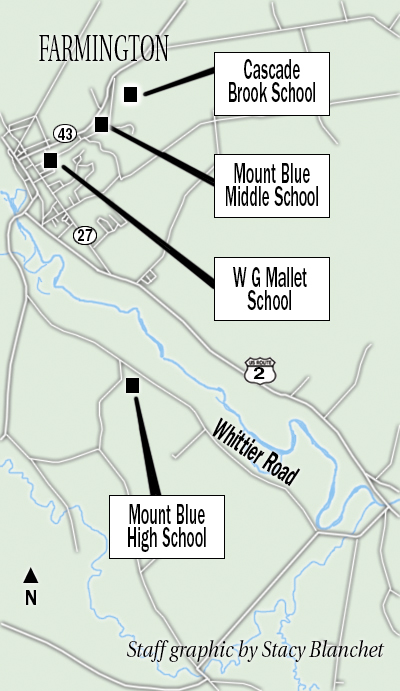FARMINGTON — A slowly developing project to save a road increasingly threatened by riverbank erosion may be the only one of its kind on the East Coast.
Environmental Consultant Rick Jones, who has been working to get permits for the bank stabilization project for about a year, said that no other project of this kind has been proposed in the river habitat of the endangered Atlantic salmon.
“We’re treading new ground here,” Jones said. “The salmon was only recently listed as an endangered species.”
As the river cuts closer to the road, the local school district and at least two oil companies have rerouted their traffic around the area.
Since early spring, the town has been seeking federal approval for a $277,170 project that would stabilize the riverbank of the Sandy River, which is eroding its banks and threatens to destroy a portion of Whittier Road.
The erosion began last August, when tropical storm Irene caused a 15,000-square-foot section of the bank to slough into the river.
“It’s really unfortunate that this has dragged out as far as this,” Jones said. “It’s been a year that this has been in the works.”
The Federal Emergency Management Agency has asked the town for a biological assessment that will measure the impact of the river bank stabilization project on endangered Atlantic salmon, which use the Sandy River as a critical spawning habitat.
However, the federal agency has not clearly identified what elements should be included in the assessment.
“There is no real outline that the federal agencies give us,” Jones said.
Jones has proposed an outline for the assessment, which would explain the effects of the project on every natural resource that could have an impact on salmon, from the water temperature to the vegetation that grows along the water.
Town Manager Richard Davis said that he expects a long review process for the outline, which was submitted to the federal agency last week.
“Since we are the first one, in Maine anyway, and it involves this resource that they care so much about, I expect that they would give our outline extra critical scrutiny,” Davis said.
Once the outline has been approved, Jones said that he could complete the actual assessment in four or five weeks.
The bank stabilization project can’t begin until next July, because work can be done on the river only when the salmon are not spawning, a period that begins Sept. 15. Local officials have said that the road is likely to collapse into the river before next summer.
Bus routes changed
David Leavitt, director of support services at Farmington-based Regional School Unit 9 said that a pre-emptive decision to reroute buses at the beginning of the school year is going smoothly.
“It was simpler for us to start the school year with the changes rather than change a week or two into the school year,” he said.
The new routes, which affect nearly 20 daily bus trips, come at an estimated cost of $28,000 for the school year, Leavitt said.
Affected students, most of whom come from Chesterville and New Sharon, face bus rides that are 10 minutes longer in each direction, Leavitt said.
Leavitt said that he hasn’t heard any complaints from parents.
“They don’t want to jeopardize their kids either,” he said.
Denis Castonguay, Farmington public works director, said that delivery trucks from Dead River Oil Company and CN Brown have also altered their routes to avoid the road.
Castonguay said that, since mid-August, another foot of riverbank has been lost, bringing the riverbank to within 30 feet of the road’s shoulder.
Davis said rain forecast for the next two weeks could accelerate the erosion.
Copy the Story LinkSend questions/comments to the editors.



Success. Please wait for the page to reload. If the page does not reload within 5 seconds, please refresh the page.
Enter your email and password to access comments.
Hi, to comment on stories you must . This profile is in addition to your subscription and website login.
Already have a commenting profile? .
Invalid username/password.
Please check your email to confirm and complete your registration.
Only subscribers are eligible to post comments. Please subscribe or login first for digital access. Here’s why.
Use the form below to reset your password. When you've submitted your account email, we will send an email with a reset code.